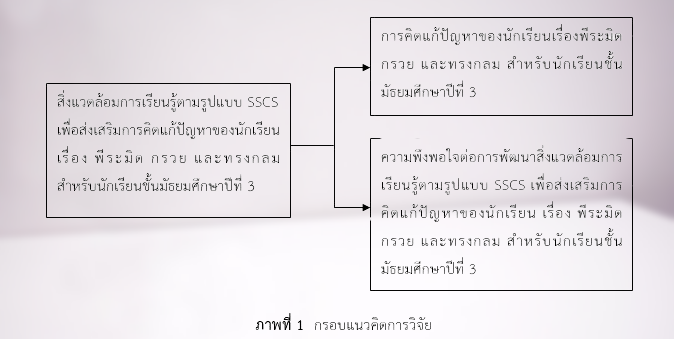Thitikant Phooarram The Development of a Network-Based Learning Environment Based on the SSCS Model to Promote Problem-Solving Thinking on Pyramids, Cones, and Spheres for 9th Grade Students
Main Article Content
Abstract
DOI : 10.14456/pnuhuso.2024.20
This study aims to: 1)design and develop a network-based learning environment grounded in the SSCS model to enhance students' problem-solving skills concerning pyramids, cones, and spheres , 2) assess the impact of the SSCS model on students' problem-solving abilities, and 3) evaluate student satisfaction with the SSCS model. The sample consisted of 24 Mathayom 3 (9th grade) students from Ban Nong Saeng School Data analysis included frequency, percentage, mean, S.D. and t-test.
The research results revealed that: 1) The SSCS model-based learning environment effectively promoted problem-solving thinking in Mathayom 3 students regarding pyramids, cones, and spheres, incorporating six elements: (1) problem situations, (2) learning resources, ( 3) knowledge exchange, (4) problem-solving skills promotion center, (5) support base, and (6) coaching. 2) Students demonstrated a statistically significant improvement in problem-solving scores post-intervention, at the .05 significance level. 3) Overall, students expressed high satisfaction with the SSCS-based network learning environment, with an average satisfaction score of 4.69.
Article Details

This work is licensed under a Creative Commons Attribution-NonCommercial-NoDerivatives 4.0 International License.
References
กฤษฎา ขุนอาจ, คงรัฐ นวลแปง, ผลาดร สุวรรณโพธิ์ และขณิชถา พรหมเหลือง. (2562). ผลการจัดการเรียนรู้แบบเปิดผสมผสานโมเดล SSCS ต่อความสามารถในการแก้ปัญหาและความสามารถในการเชื่อมโยงทางคณิตศาสตร์ของนักเรียนหอพักชั้นมัธยมศึกษาปีที่ 2. วารสารศึกษาศาสตร์ มหาวิทยาลัยนเรศวร, 21(4), 34-46. https://so06.tci-thaijo.org/index.php/edujournal_nu/article/view/95170/15 1822
ณิชา พันธ์กนก. (2565). การจัดการเรียนรู้แบบ SSCS เพื่อพัฒนาความสามารถในการแก้ปัญหาทางคณิตศาสตร์ของนักเรียนชั้นมัธยมศึกษาปีที่ 5 [วิทยานิพนธ์ปริญญามหาบัณฑิต, มหาวิทยาลัยมหาสารคาม]. http://202.28.34.124/dspace/bitstream/123456789/1643/1/63010552021. pdf
ธันยพัฒน์ พันธุ์พำนัก. (2563). การจัดการเรียนรู้ด้วยรูปแบบ SSCS เพื่อส่งเสริมผลสัมฤทธิ์ทางการเรียนและทักษะการแก้ปัญหาทางคณิตศาสตร์ เรื่อง ความน่าจะเป็น ชั้นมัธยมศึกษาปีที่ 3 [วิทยานิพนธ์ปริญญามหาบัณฑิต, มหาวิทยาลัยมหาสารคาม]. http://202.28.34.124/dspace/bitstream/123456789/ 145/1/60010283013.pdf
นริศรา สำราญวงษ์, อำพันธ์ชนิต เจนจิต และคงรัฐ นวลแปง. (2560). พัฒนาทักษะการแก้ปัญหาทางคณิตศาสตร์และผลสัมฤทธิ์ทางการเรียนทางคณิตศาสตร์ผ่านการจัดการการเรียนรู้โดยใช้แบบจำลอง SSCS ข้อมูลการสมัครสำหรับนักเรียนชั้นประถมศึกษาปีที่ 5. วารสารศึกษาศาสตร์ มหาวิทยาลัยนเรศวร, 19(1), 254-264. https://so06.tci-thaijo.org/index.php/edujournal_nu/article/view /79140/63293
วรรณนิภา สารสุวรรณ. (2563). ผลการจัดกิจกรรมการเรียนรู้วิธีการแบบเปิด (Open Approach) ที่มีต่อผลสัมฤทธิ์ทางการเรียนคณิตศาสตร์ และความสามารถในการแก้ปัญหาทางคณิตศาสตร์ของนักเรียนชั้นประถมศึกษาปีที่ 5 [วิทยานิพนธ์ปริญญามหาบัณฑิต]. มหาวิทยาลัยรามคำแหง.
เพชราภรณ์ เฮมกลาง และสุมาลี ชัยเจริญ. (2560). การออกแบบของสิ่งแวดล้อมทางการเรียนรู้ผ่านการสังเคราะห์ตามแนวคอนสตรัคติวิสต์ เรื่อง โครงสร้างโลกของเรา สำหรับนักเรียนชั้นมัธยมศึกษาปีที่ 2. วารสารมนุษยศาสตร์และสังคมศาสตร์, 8(2), 1-18.
อารยา ยุวนะเตมีย์. (2560). การเปรียบเทียบการพัฒนาความสามารถในการแก้ปัญหาทางคณิตศาสตร์และการพัฒนาการรับรู้ความสามารถ การรับรู้ความสามารถตนเองทางคณิตศาสตร์ของนักเรียนมัธยมศึกษาตอนต้นโดยใช้วิธีประเมินตนเองต่างๆ การใช้รูบริกคำอธิบายประกอบและวิธีการสำรวจปลายเปิด[วิทยานิพนธ์ปริญญามหาบัณฑิต]. จุฬาลงกรณ์มหาวิทยาลัย.
ศรีสุดา อ่อนบัตร. (2563). การศึกษาความสามารถในการแก้ปัญหาทางคณิตศาสตร์เรื่อง พื้นที่ผิวและปริมาตรของนักเรียนชั้นมัธยมศึกษาปีที่ 3 ผ่านกิจกรรมการเรียนรู้ตามแนวสะเต็มศึกษา [วิทยานิพนธ์ปริญญามหาบัณฑิต]. มหาวิทยาลัยศรีนครินทรวิโรฒ.
สุระ น้อยสิม และสุชาติ วัฒนชัย. (2563). ผลของสิ่งแวดล้อมทางการเรียนรู้บนเครือข่ายตามแนวคอนสตรัคติวิสต์ที่ส่งเสริมการคิดวิเคราะห์ การเขียนโปรแกรมด้วยภาษาซี เรื่อง คำสั่งควบคุมสำหรับนักเรียนชั้นมัธยมศึกษาปีที่ 5. วารสารบัณฑิตศึกษา มหาวิทยาลัยราชภัฏสกลนคร, 17(77), 50-61. https://so02 .tci-thaijo.org/index.php/SNGSJ/article/view/162930/165041
Jonassen, D. (1999). Designing constructivist learning environments. In C. Reigeluth, (Ed.), Instructional- design theories and models: A new paradigm of instructional theory. University Park: Pennsylvania State University.
Pizzini, E.L., Shepardson, D.P., & Abell, S.K. (1989). A rationale for and the development of a problem solving model instruction in Science Education. Science Education, 75(5), 523-534. https://doi.org/10.1002/sce.3730730502
Riasat, A. (2010). Effect of Using Problem Solving Method in Teaching Mathematics on the Achievement of Mathematics Students. Asian Social Science, 6(2), 67–72.
Yasin, M., Fakhri, J., Siswadi, Faelasofi, R., Safi’i, A., Supriadi, N., Syazali, M., & Wekke, I.S. (2020). The effect of SSCS learning model on reflective thinking skills and problem solving ability. European Journal of Educational Research, 9(2), 743-752. https://doi. org/10.12973/eu-jer.9.2.743


